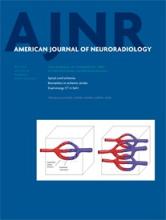Research ArticleBrain
Open Access
Diffusion and Perfusion MRI to Differentiate Treatment-Related Changes Including Pseudoprogression from Recurrent Tumors in High-Grade Gliomas with Histopathologic Evidence
A.J. Prager, N. Martinez, K. Beal, A. Omuro, Z. Zhang and R.J. Young
American Journal of Neuroradiology May 2015, 36 (5) 877-885; DOI: https://doi.org/10.3174/ajnr.A4218
A.J. Prager
aFrom the Departments of Radiology (A.J.P., R.J.Y.)
N. Martinez
bNeurology (N.M., A.O.)
K. Beal
cRadiation Oncology (K.B.)
ethe Brain Tumor Center (K.B., A.O., R.J.Y.), Memorial Sloan Kettering Cancer Center, New York, New York.
A. Omuro
bNeurology (N.M., A.O.)
ethe Brain Tumor Center (K.B., A.O., R.J.Y.), Memorial Sloan Kettering Cancer Center, New York, New York.
Z. Zhang
dEpidemiology and Biostatistics (Z.Z.)
R.J. Young
aFrom the Departments of Radiology (A.J.P., R.J.Y.)
ethe Brain Tumor Center (K.B., A.O., R.J.Y.), Memorial Sloan Kettering Cancer Center, New York, New York.

Submit a Response to This Article
Jump to comment:
No eLetters have been published for this article.
In this issue
American Journal of Neuroradiology
Vol. 36, Issue 5
1 May 2015
Advertisement
A.J. Prager, N. Martinez, K. Beal, A. Omuro, Z. Zhang, R.J. Young
Diffusion and Perfusion MRI to Differentiate Treatment-Related Changes Including Pseudoprogression from Recurrent Tumors in High-Grade Gliomas with Histopathologic Evidence
American Journal of Neuroradiology May 2015, 36 (5) 877-885; DOI: 10.3174/ajnr.A4218
Diffusion and Perfusion MRI to Differentiate Treatment-Related Changes Including Pseudoprogression from Recurrent Tumors in High-Grade Gliomas with Histopathologic Evidence
A.J. Prager, N. Martinez, K. Beal, A. Omuro, Z. Zhang, R.J. Young
American Journal of Neuroradiology May 2015, 36 (5) 877-885; DOI: 10.3174/ajnr.A4218
Jump to section
Related Articles
- No related articles found.
Cited By...
- "Synthetic" DSC Perfusion MRI with Adjustable Acquisition Parameters in Brain Tumors Using Dynamic Spin-and-Gradient-Echo Echoplanar Imaging
- Identification of a Single-Dose, Low-Flip-Angle-Based CBV Threshold for Fractional Tumor Burden Mapping in Recurrent Glioblastoma
- Arterial Spin-Labeling and DSC Perfusion Metrics Improve Agreement in Neuroradiologists Clinical Interpretations of Posttreatment High-Grade Glioma Surveillance MR Imaging--An Institutional Experience
- Volumetric Measurement of Relative CBV Using T1-Perfusion-Weighted MRI with High Temporal Resolution Compared with Traditional T2*-Perfusion-Weighted MRI in Postoperative Patients with High-Grade Gliomas
- Spatiotemporal Heterogeneity in Multiparametric Physiologic MRI Is Associated with Patient Outcomes in IDH-Wildtype Glioblastoma
- Centrally Reduced Diffusion Sign for Differentiation between Treatment-Related Lesions and Glioma Progression: A Validation Study
- Diagnostic Performance of PET and Perfusion-Weighted Imaging in Differentiating Tumor Recurrence or Progression from Radiation Necrosis in Posttreatment Gliomas: A Review of Literature
- 18F-FET PET Imaging in Differentiating Glioma Progression from Treatment-Related Changes: A Single-Center Experience
- Response Assessment in Neuro-Oncology Criteria for Gliomas: Practical Approach Using Conventional and Advanced Techniques
- Perfusion MRI-Based Fractional Tumor Burden Differentiates between Tumor and Treatment Effect in Recurrent Glioblastomas and Informs Clinical Decision-Making
- Utility of Dynamic Susceptibility Contrast Perfusion-Weighted MR Imaging and 11C-Methionine PET/CT for Differentiation of Tumor Recurrence from Radiation Injury in Patients with High-Grade Gliomas
- Multiparametric Evaluation in Differentiating Glioma Recurrence from Treatment-Induced Necrosis Using Simultaneous 18F-FDG-PET/MRI: A Single-Institution Retrospective Study
- A Simple Automated Method for Detecting Recurrence in High-Grade Glioma
- Osseous Pseudoprogression in Vertebral Bodies Treated with Stereotactic Radiosurgery: A Secondary Analysis of Prospective Phase I/II Clinical Trials
This article has not yet been cited by articles in journals that are participating in Crossref Cited-by Linking.
More in this TOC Section
Similar Articles
Advertisement











